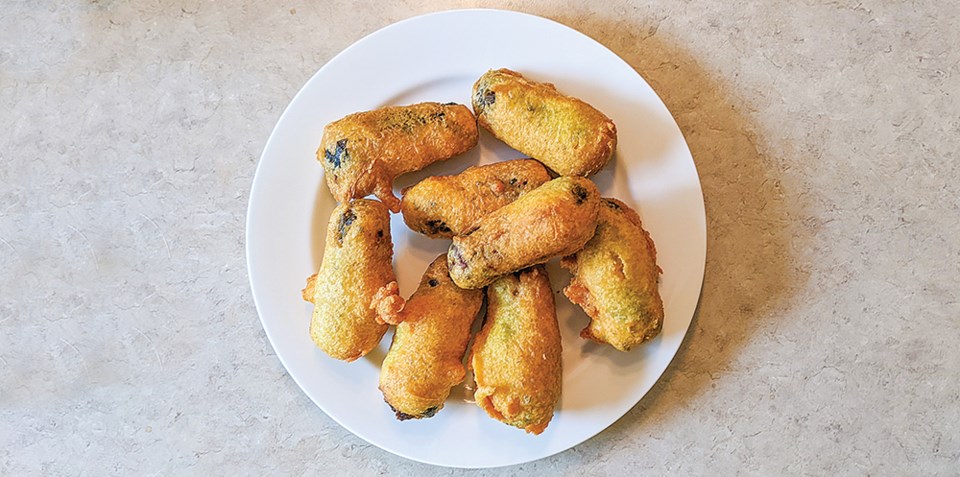It was the return of the CNE, I’m sure, with this year’s new culinary atrocities, that led to this. I can’t swear to it because I rarely remember my dreams, but certainly a nightmare involving the Exhibition’s announced ketchup and mustard ice cream flavours must have influenced my thinking, for I woke up one morning last week and said to myself, “Yes, we must try dolma, deep-fried in chickpea batter.”
Before I lose you at the top, the good news is that for this recipe you don’t have to make the dolma—there are plenty waiting for you at the grocery store.
What are dolma? Only the most savoury little morsels to come out of Greece since Adonis and Aphrodite (more on this in a second). Take cooked rice, add some seasonings, wrap up in a grape leaf, then roll into a mini log that’s about the size of a large lipstick or an obese AA- battery. There are several variations, including with meat, but that’s the basic idea.
I first encountered dolma in Athens several years back in the previous century. I was not long out of university and it was my first trip to Greece, on this occasion as a bottom-rung, junior member of a Canadian trade delegation. Neither the industry nor specific names need be mentioned, but on the first evening at dinner I found myself in an international hotel’s banquet room, seated next to a Greek cabinet minister at a long table in the company of about 20 Canadians and 20 Greeks, nationalities alternating by seat. I haven’t the slightest memory of who sat on my other side, because Minister X immediately launched into a soliloquy on the heritage and history of the beloved, humble dolma, piled high on plates along the table, and which—I was firmly advised not to be fooled on this point—was definitely Greek in origin and not Turkish.
“Everything,” the Minister asserted confidently in excellent English, “started in Greece.”
The dolma (in Greek, dolmades) on offer were indeed delicious. So was I, it turned out. Through my jet-lagged exhaustion it took me longer than it should have to realize that Minister X was making a pass at me, his repeated “joking” comparisons of me to Adonis finally clicking.
When a suitable opening presented itself I mumbled something about being quite tired and politely declined the overture, passing on the pass, although not necessarily for the reason you might assume. This was, after all, shortly after the peak of an era of sexual liberation and newfound personal freedoms. No, he had mentioned his family, including a son not all that younger than I away at an English boarding school, and this was unsettling on some Freudian level that proved a Peloponnese bridge too far.
(Hearing this story not long after we met, my wife-to-be started calling me “Adonis,” with just a touch of sarcasm, and did so for some years after we married. I fear the nickname is about to be resurrected.)
In any case, dolma are delicious, soft little treats, typically eaten at room temperature, with yogurt or other sauces for dipping. But out of the blue last week, I found myself wondering what a soft dolma might taste like surrounded by a crispy, crunchy shell. Our go-to for deep frying vegetables is chickpea batter, and so the experiment commenced.
Conclusion: It’s unusual, but delicious.
Finding dolma
I haven’t checked every local supermarket (and, as previously noted in this space, on principle we do not shop at Fonthill Sobeys), so I can’t promise that you’ll find dolma on your favourite store’s shelves. I can guarantee, however, that you will find them, as it happens, in the Fonthill Dollarama.
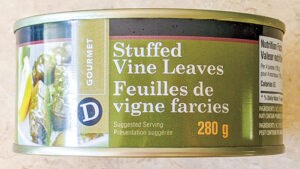
Outside of Greek or Mediterranean restaurants where they are made fresh, the only dolma I’m aware of come canned, and that’s what you’ll find at Dollarama. As you see in the photo, they are labelled “Stuffed Vine Leaves,” and, to what would surely be Minister X’s great chagrin, they are imported from Turkey.
Don’t let the canned part dissuade you. This is just a snack we’re making here. The canned quality is more than adequate.
Why chickpea batter
Chickpea batter is tastier than a plain flour batter, although a 100 percent white flour batter is also an option. If you don’t have it or can’t be arsed to buy it, just replace the chickpea flour with all-purpose flour. Note, however, that chickpea flour is both higher in protein than white flour as well as gluten free, if that’s important to you.
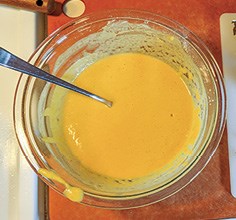
Strictly speaking, the tastiest chickpea flour is actually “Gram” (also known as “Besan”) flour, which is made from a different variety of chickpea. Gram/Besan flour is typically available only in South Asian or Caribbean grocery stores. Everywhere else, you’ll find it called chickpea or garbanzo bean flour, and it’s available widely, including at South Pelham Sobeys, Zehrs, and at Bulk Barn. Either variety is fine for this recipe.
In fact, for maximum fried crispiness, the ideal mixture is a blend of flours, as you’ll see below.
Easy deep-frying
Also, don’t let the deep-frying part put you off. All you’ll need is a small, heavy-bottom, stainless steel saucepan or pot, the smaller the better so as to use as little oil as possible. The dolma are small, and there are only ten of them in a can. Cooking them in batches of three and four gives you plenty of room to spare in a 1 qt. pan, and you don’t need to use more than 2 cups of oil.
In my case, I had some lightly used peanut oil in the fridge and so used that, but canola is fine. Do not use olive oil as its flavour is too intrusive. (It’s a myth that olive oil can’t be used for deep frying, but if you do it’s essential to use extra virgin olive oil, which makes it far more expensive that canola.)
An excellent tool but not absolutely required is a kitchen thermometer with remote probe, so that you can constantly monitor your oil temperature and adjust heat as necessary. Finally, whenever deep frying, you’ll always want a kitchen fire extinguisher within easy reach. We pull ours out of the pantry closet and set it on the floor a few feet away from the stove. In combating grease fires, seconds count.
Crispy Deep Fried Dolma
Ingredients
1/4 cup chickpea flour
1/4 cup all-purpose flour
1/4 cup rice flour (or substitute 2 Tbs of cornstarch)
1-1/2 tsp baking powder
1/2 tsp salt
1/4 tsp turmeric
1/4 tsp ground coriander
1/8 tsp chili powder or cayenne pepper
3/4 cup of warm water
1 can of prepared dolma
Preparation
1. Always mix wet into dry. First combine all the flours and other dry ingredients in a medium sized bowl. Slowly mix in the water, avoiding lumps. Err on the side of a thicker than thinner batter. It should be slightly thicker than pancake batter, and will adhere better to the dolma. If it’s too stiff, though, add more water. Let the batter rest for 30 minutes up to an hour.
2. Open your $1.50 can of Dollarama dolma. You will find nine or ten little dark green logs, packed in sunflower oil. We need to rid the dolma surfaces of that oil. I found the easiest way to do this was wrapping each dolma in a paper towel and gently rolling it so the paper absorbed the oil. Place another paper towel on a large plate and arrange the dried dolma on it to absorb any last drops. Handle the dolma carefully, as they are a bit fragile.
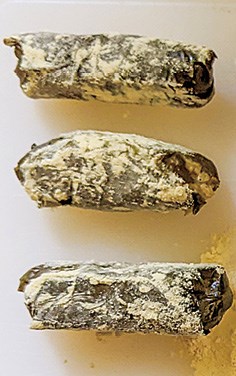
3. On a second large plate or plastic cutting board (don’t use wood, as the remaining sunflower oil will stain it), dust the surface with a good dollop of chickpea or all-purpose flour. One by one, roll the dolma in the flour, coating each as best as you can. Don’t worry if they aren’t dead perfect.
4. Bring your oil to temperature over medium-high heat. In a small, heavy-bottomed saucepan, heat the least amount of oil you think you’ll need to submerge three or four dolma at once. For me this was 2 cups of oil in a 1 qt. pan. As noted above, use a neutral flavour oil with high smoke point. Canola is ideal. Now, since the dolma are already moist in their little green blankets, it’s important to get them as crispy as possible as fast as possible. The longer the dolma are in the oil, the more risk that they’ll steam from the inside, eroding your crispy crust. Remember, the dolma are already cooked. All we’re doing here is cooking the batter coating. Therefore we’re going to heat our oil to the maximum range for deep frying: 375-380F. This is when a probe or candy thermometer comes in handy—not just to judge the initial temperature, but also to ensure between batches that the oil regains its heat.
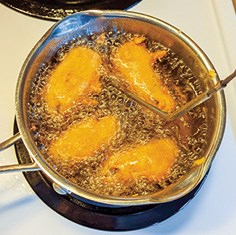
5. Once your batter has rested 30 minutes and your oil is heated you are ready to roll. (Hint: If your probe thermometer has an alarm, set it to 500 degrees to avoid the annoying beeping once the oil hits 375-380.) Dip the dolma in the batter and liberally coat them, then carefully drop each into the oil using tongs or a fork. You’ll be able to fit four into a 1 qt. pan. The oil temperature will drop immediately. Turn the heat up slightly to bring the oil back to 375-380. Stay alert. Ensure that the dolma don’t stick together or to the bottom of the pan by gently pushing them with a knife. It won’t take longer than two minutes to get to a golden brown crust if you are diligent about keeping the oil hot. Once the colour is there, use a slotted spoon or a fork to remove from the pan and place on a plate covered with a paper towel to absorb excess oil
6. Repeat as many times as needed. Make sure your oil temperature returns to 375-380F before dropping in each new batch. (Note: If you have leftover batter, trying using it to coat some onion slices, green beans, or other sliced vegetables. Delicious!)
These dolma are best consumed fresh, although in theory they might reheat reasonably well in a toaster oven set to 400F for ten minutes. I didn’t test this, since we were hungry enough to dive right in and knock them all off at once. Be careful—they will remain very hot inside long after you finish frying all ten.
For dipping you could go with tzatziki sauce or Greek yogurt. For a real multicultural experience, you could also try an Asian sweet chili sauce. Or just enjoy the crispy crust without additional ornamentation.
Is your stomach rumbling with desire? Don’t fight it. As the Greeks say: «Είναι δύσκολο να διαφωνήσεις με την κοιλιά, καθώς δεν έχει αυτιά»
It is difficult to argue with the belly, as it has no ears.
